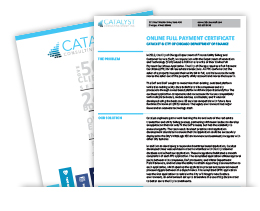
The Problem 
Established in 1953, the Illinois Tollway system is composed of four major toll roads that stretch across 286 miles of Illinois. On a daily basis the Tollway handles millions of transactions, totaling close to a billion or more annual transactions. They serve over four million customers bringing in over $1 billion in annual revenue. Currently, electronic toll revenue is the core of the business system comprising 85 percent of the Tollway’s revenue. This number will continue to grow exponentially as the Tollway continues to implement all-electronic roads and interchanges.
In the spring of 2014, the Illinois Tollway realized a replacement for its customer service and violation processing system was necessary for this continued, successful growth. The 2005 system no longer supported their goals of reducing operational costs, improving customer service cycle times, and embracing improved customer service policies such as shorter violation notice cycles and dynamic management of fines and settlements. To scale their business both vertically and horizontally, the Tollway received a “best of breed” enterprise back office solution developed by SAP and Accenture called the Accenture Tolling Solution (ATS). With their new solution ready, it was clear that to ensure proper implementation the Tollway needed a solution integrator with technical and business experience implementing and running enterprise-level business applications like the ATS. Without proper implementation, the Tollway’s ability to collect electronic tolls would be jeopardized, leaving their core business and operations at risk.
Our Solution
The Tollway awarded Jacobs Engineering Group (Jacobs) the System Integrator Services contract in conjunction with Catalyst. Together Catalyst and Jacobs provided the Tollway with technical and business experience implementing and running enterprise-level business applications like the ATS to provide oversight and to monitor the post go-live System processing, operational characteristics, user experience, and performance. At the onset of the project, Catalyst placed multiple senior-level consultants and management staff at the Tollway to first learn the ins and outs of its business and establish a strong foundation. Once the team was comfortable with the Tollway’s business operations, they applied their experience in risk management to ensure proper identification, mediation, mitigation, and escalation was applied to any and all issues that arose within the project. Project documentation and meetings implemented by Catalyst on a weekly basis ensured all teams were frequently updated on the status of all project work streams. Catalyst’s flexible customer engagement style established a strong foundation of trust and allowed for the team to easily collaborate with the Tollway to achieve critical project milestones.
During the design, build, and testing phases of the project, Catalyst utilized its most senior infrastructure and application technical resources to provide ample guidance. The team utilized its knowledge of PCI compliance to ensure all network setup and implementation was completed properly and to the highest industry standard. Specifically, Catalyst provided guidance and assessment on the configuration of the VmWare ESX Host and Citrix XenApp. On many occasions the team provided key research, feedback, and knowledge of past experience as it related to database, server virtualization, operational configurations, and maintenance considerations. Specifically, the team provided guidance and assessment on the configuration and implementation of SAP Netweaver, Oracle Golden Gate and 11g/12C, and ATS NetApp and Cisco UCS. Often times this feedback was crucial to the success and continuance of the project.
In providing proper communication, resource utilization, transparency, and collaboration, Catalyst proved to the Tollway it is a trustworthy and long-term partner. Through this engagement, the Tollway and Accenture have both looked to utilize Catalyst in future endeavors. The ATS went live August 2016.
“Catalyst is a wonderful partner for any organization going through significant technological evolution. Their team represents a deep and diverse set of skills and experiences that ensures we always have someone to rely upon for guidance, even when the questions and challenges we have are esoteric and complex. We are grateful for the input and leadership of our Catalyst partners every step of the way”
– Shana Whitehead, Chief of Business of Systems at the Tollway




Recent Comments